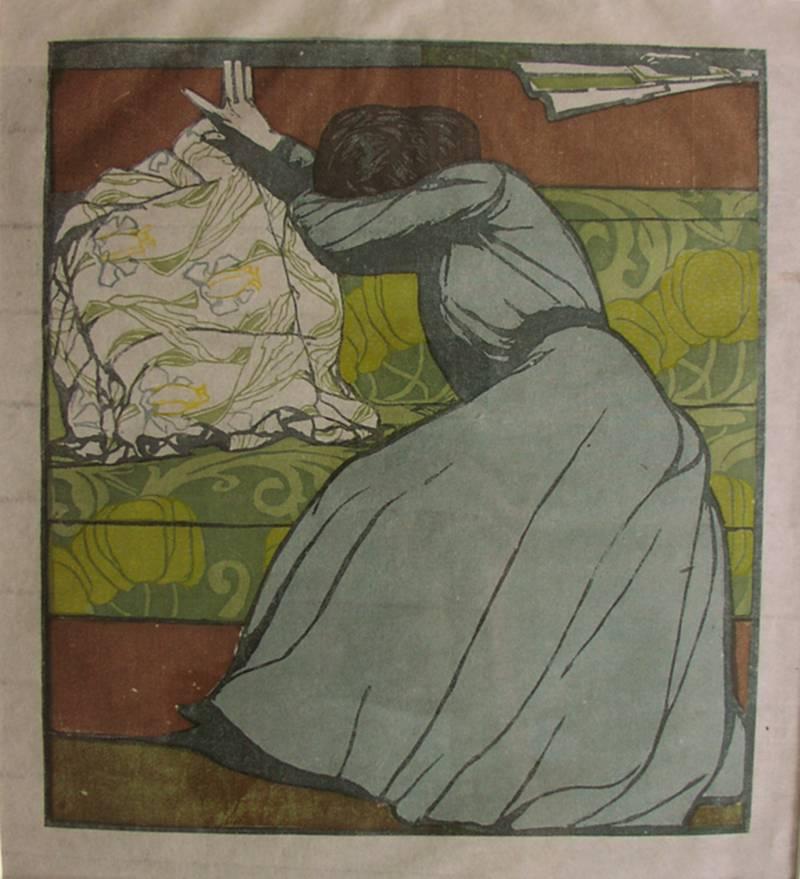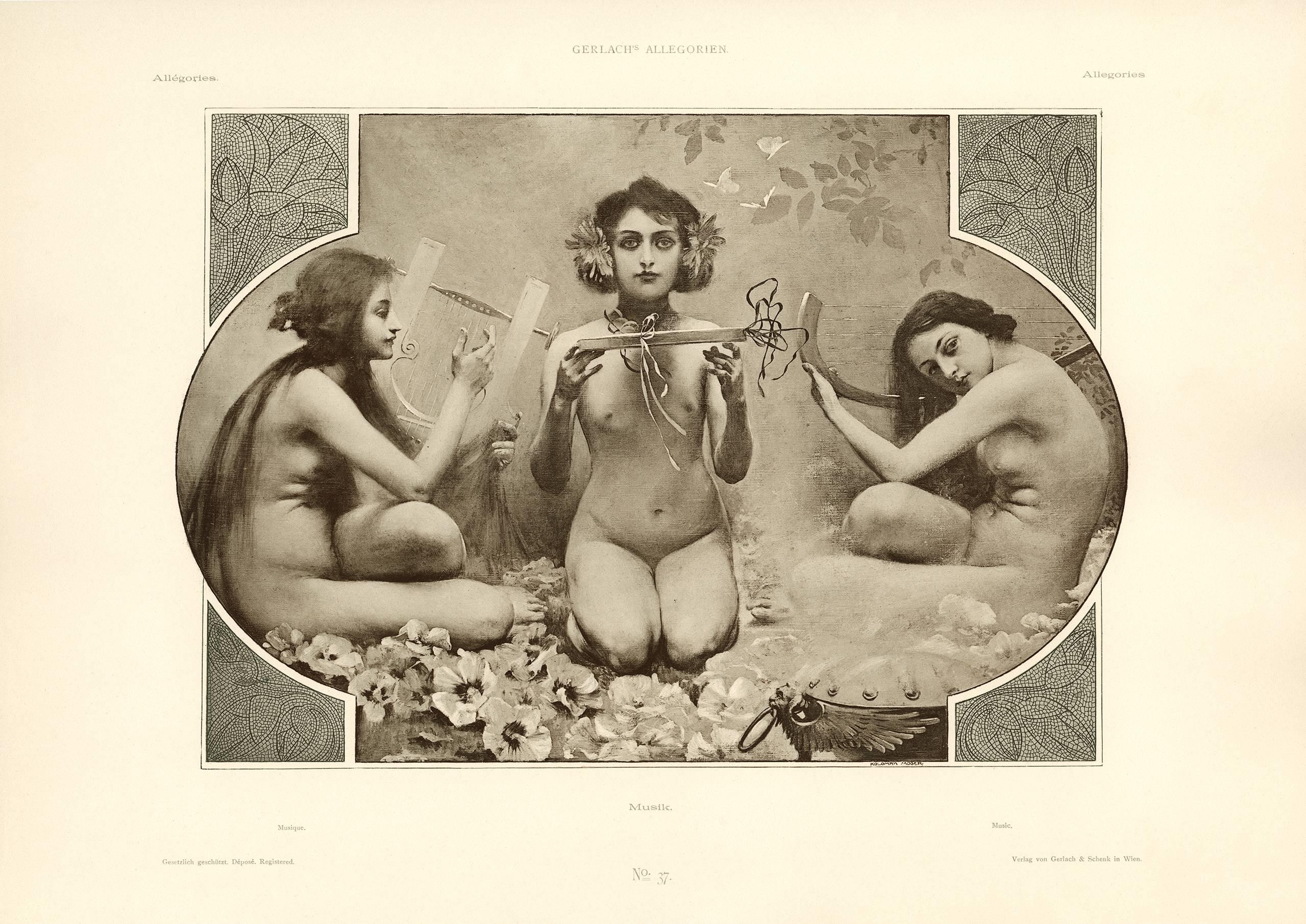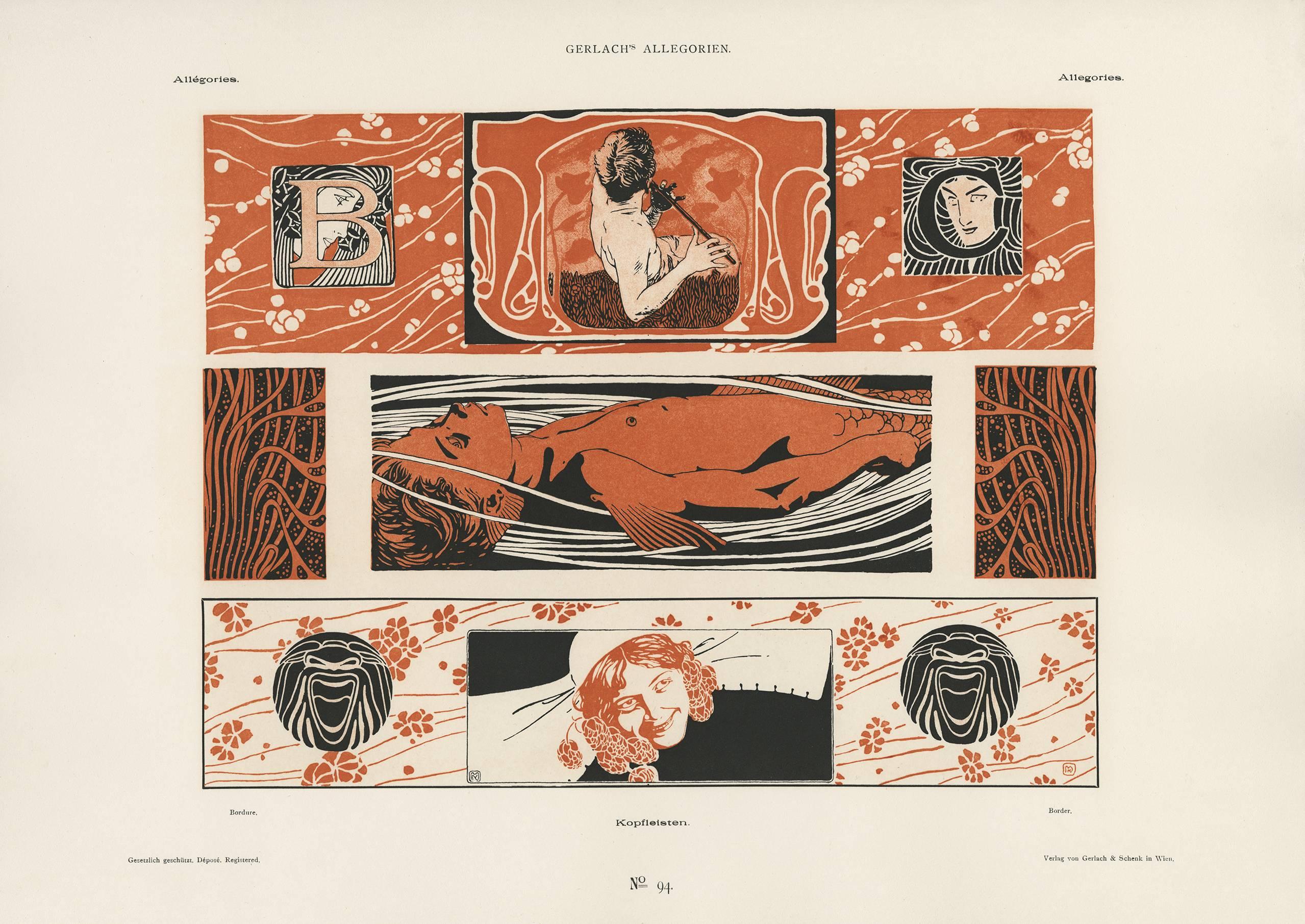Items Similar to Sema portfolio, 1912, "Male Nude I" Lithograph print 21/215
Want more images or videos?
Request additional images or videos from the seller
1 of 7
Egon SchieleSema portfolio, 1912, "Male Nude I" Lithograph print 21/2151912
1912
About the Item
MALE NUDE (SELF-PORTRAIT) I by Egon Schiele, 1912, a brush and ink lithograph on vellum paper made for the Munich-based artists’ association, Sema 15 Originalsteinzeichnungen portfolio; Delphin-Verlag printer; the image is numbered 21 out of an edition of 215, and the sheet measures 17 3/8” x 15 3/4”; signed in the stone Egon Schiele and dated 1912 in the lower right; signed, dated and numbered by the artist in pencil in the lower left to the right of the Sema printed signet. (Kallir G. 1) Formerly in the Michael and Dorothy Blankfort collection of The Los Angeles County Art Museum, original labels verso.
Egon Schiele. a prolific draftsman, made his first print - one of only 17 graphic works created before his death in 1918 - shortly after he was invited to join the Munich artists’ association, Sema, in 1911 when he was just 21 years old. In a brutally overt, expressionist manner for which he has come to be known, Schiele’s first graphic work is the ultimate calling card announcing the artist’s arrival to the world. Naked, oddly confrontational in an open stance, yet simultaneously vulnerable and rendered physically impotent with a mutilated penis and missing limbs, Schiele conveys a powerful dissonance which sets the tone to force the viewer into considering the image as a psychological portrait. Schiele gives his figure no props such as clothing or spatial-temporal clues and thus dismisses the surface and emphasizes the substance. The most potent and concentrated areas of ink depict nothing from the observable world. Rather, the strong black outline, almost phantasmal in its thick application behind and along the hips and thighs, between the arm and torso and above the shoulder to curve around the head, finds its way to the genitalia and to the mouth in such a manner as to overtake the form, to silence and render the physical powerless. Schiele, the masterful artist, transcends the limitations of naturalism or allegory and transports the viewer to this psychogenic state of self-portraiture through the physical gesture of energetically applied ink. He uses these gestural movements, contortion and amputation of body parts as a means to access the inner state.
In Egon Schiele: A Self In Creation, Danielle Knafo astutely recognizes this subjective emphasis of Schiele’s work, particularly as it relates to his voluminous output of 250 self-portraits. “Through his confessional self-portraits, Schiele laid his life out on canvas and embarked on an analysis of his personality as deep and ruthless as Freud’s analysis of himself.”
Syphilis, which plagued Europe in the 19th and early 20th century, infiltrated the Schiele home with wide-ranging and deeply troubling effects. Schiele’s father contracted the disease, passed it on to his wife and lost four of their seven children to complications from the illness before going mad, becoming paralyzed, and finally dying when Egon was fourteen years old, forever cementing the connection of sex and death into Schiele’s psyche. These traumas of Schiele’s childhood became just as significant to his life as any experience. They assumed space in his being no differently than a vital organ, perhaps more so than certain body parts.
“…this probing into the psychology of experience, especially as it relates to childhood, to gain understanding of psychosis and human pathos firmly roots Schiele’s modern artistic expression to contemporary Vienna.” Schiele’s deeply personal analysis was a conscious one. His figural image conveys this with a directness that is aggressively confrontational. It is Schiele’s eyes which burn into the viewer with the double intensity of a voyeur and an all-seeing artist capable of capturing and reconciling the inconsistency of inner and outer states. This is no dream. Schiele’s eyes are wide open.
With this first graphic work, Schiele masterfully presents a very modern form of self-portraiture. There is certainly a young bravado about the virtuosity and spontaneity of his brush. The lithographic medium was clearly conducive to his fluid and unrestrained approach to drawing. Coupled with his intense gaze, the saturation of ink or the essence of himself, and the manipulation of his human anatomy, Schiele dares the viewer to confront him - the real Egon Schiele - and marvel at his abilities to bring full expression to the abstract inner state and give it form.
- Creator:Egon Schiele (1890-1918, Austrian)
- Creation Year:1912
- Dimensions:Height: 17.3 in (43.95 cm)Width: 15.75 in (40.01 cm)
- Medium:
- Movement & Style:
- Period:
- Condition:See: Egon Schiele: The Complete Works, by Jane Kallir. 1990. Formerly in the Michael and Dorothy Blankfort collection of The Los Angeles County Art Museum, original labels verso.
- Gallery Location:Chicago, IL
- Reference Number:1stDibs: LU46731419883

About the Seller
5.0
Gold Seller
These expertly vetted sellers are highly rated and consistently exceed customer expectations.
Established in 2013
1stDibs seller since 2016
82 sales on 1stDibs
Typical response time: 2 hours
- ShippingRetrieving quote...Ships From: Chicago, IL
- Return PolicyA return for this item may be initiated within 3 days of delivery.
More From This SellerView All
- Gerlach's Allegorien Plate #116: "Force, Thirst, Love" LithographBy Carl Otto CzeschkaLocated in Chicago, ILafter Carl Otto Czeschka, (1878-1960), Austrian A leading member of the Vienna Secession and later the Wiener Werkstätte (Viennese Workshop), Carl Otto Czeschka was a vital figu...Category
1890s Vienna Secession Figurative Prints
MaterialsLithograph
- Gerlach's Allegorien Plate #37: "Music" LithographBy Koloman MoserLocated in Chicago, ILKoloman Moser (1868 –1918), AUSTRIAN Instead of applying his flair and art education solely to painting, Koloman Moser embodied the idea of Gesamt Kunstwerk (all-embracing art w...Category
1890s Vienna Secession Figurative Prints
MaterialsLithograph
- Gerlach's Allegorien Plate #94: "Heads" LithographBy Koloman MoserLocated in Chicago, ILKoloman Moser (1868 –1918), AUSTRIAN Instead of applying his flair and art education solely to painting, Koloman Moser embodied the idea of Gesamt Kunstwerk (all-embracing art work) by designing architecture, furniture, jewelry, graphics, and tapestries meant to coordinate every detail of an environment. His work transcended the imitative decorative arts of earlier eras and helped to define Modernism for generations to come. Moser achieved a remarkable balance between intellectual structure (often geometric) and hedonistic luxury. Collaborating with Gustav Klimt and Josef Hoffmann, the artist was an editor and active contributor to Ver Sacrum, (Sacred Spring), the journal of the Viennese Secession that was so prized for its aesthetics and high quality production that it was considered a work of art. The magazine featured drawings and designs in the Jugendstil style (Youth) along with literary contributions from distinguished writers from across Europe. It quickly disseminated both the spirit and the style of the Secession. In 1903 Moser and Hoffmann founded and led the Wiener Werkstatte (Viennese Workshop) a collective of artisans that produced elegant decorative arts items, not as industrial prototypes but for the purpose of sale to the public. The plan, as idealistic then as now, was to elevate the lives of consumers by means of beautiful and useful interior surroundings. Moser’s influence has endured throughout the century. His design sensibility is evident from the mid-century modern furniture of the 1950s and ‘60s to the psychedelic rock posters...Category
1890s Vienna Secession Figurative Prints
MaterialsLithograph
- Gerlach's Allegorien Plate #98: "Poetry" Lithograph by Carl Otto CzeschkaBy Carl Otto CzeschkaLocated in Chicago, ILafter Carl Otto Czeschka, (1878-1960), Austrian A leading member of the Vienna Secession and later the Wiener Werkstätte (Viennese Workshop), Carl Otto Czeschka was a vital figu...Category
1890s Vienna Secession Figurative Prints
MaterialsLithograph
- Gerlach's Allegorien Plate #85: "Hunting" Lithograph by Carl Otto CzeschkaBy Carl Otto CzeschkaLocated in Chicago, ILafter Carl Otto Czeschka, (1878-1960), Austrian A leading member of the Vienna Secession and later the Wiener Werkstätte (Viennese Workshop), Carl Otto Czeschka was a vital figu...Category
1890s Vienna Secession Figurative Prints
MaterialsLithograph
- Gerlach's Allegorien Plate #30: "Love" LithographBy Koloman MoserLocated in Chicago, ILKoloman Moser (1868 –1918), AUSTRIAN Instead of applying his flair and art education solely to painting, Koloman Moser embodied the idea of Gesamt Kunstwerk (all-embracing art w...Category
1890s Vienna Secession Figurative Prints
MaterialsLithograph
You May Also Like
- Der PolsterBy Max KurzweilLocated in New York, NYKurzweil, Maximilian. Der Polster, 1903. Color woodcut on japon. Included as an insert in Pan. Unsigned. Framed.11 1/4 x 10 1/4. 1 Ref: Hofstatter, p. 241; Pabst, p. 154. Maximillian Kurzweil was the co-founder of the Vienna Secession in 1897 and editor and illustrator of the influential Secessionist magazine Ver Sacrum...Category
Early 1900s Vienna Secession Figurative Prints
MaterialsLithograph
- Mädchen am Fenster. 1906-08.By Oskar KokoschkaLocated in New York, NYMädchen am Fenster. 1906-08. Color lithograph printed on smooth card stock. Full margins. Tipped into a later presentaion folder, signed by the artist in pencil, on the recto. Published by the Wiener Werkstätte, Vienna, with the printed postcard text on verso. Among Kokoschka's earliest prints were a series of 14 postcards, the current work and the following lot that he produced for the Wiener Werkstätte. Wingler/Welz 4. Oskar Kokoschka was an Austrian artist, poet and playwright best known for his intense expressionistic portraits...Category
Early 1900s Vienna Secession Figurative Prints
MaterialsLithograph
- Original Vintage Secession Poster celebrating the emperor's jubileeLocated in Zurich, CHOriginal Vintage Poster by the Austrian artist Ferdinand Ludwig Graf, a member of the Hagenbund. This Viennese artist association moved as soon a...Category
Early 1900s Vienna Secession Figurative Prints
MaterialsPaper
- Untitled WoodcutLocated in Wilton, CTOriginal hand-colored woodcut from a portfolio of Secessionist fashion illustrations. Signed in the lower right margin by the artist, Reni Schaschl (1895-1979), a talented member of...Category
1910s Vienna Secession Figurative Prints
MaterialsWoodcut
- FruhlingBy Josef Siccard-RedlLocated in New York, NYSiccard-Redl, Josef. Fruhling, Ca 1910. Color wood engraving, Signed and titled in pencil by the artist. Little is known of this artist other than he worked in Vienna during the ...Category
1910s Vienna Secession Figurative Prints
MaterialsEngraving
- POLSTER (The Cushion)By Max KurzweilLocated in Santa Monica, CAMAXIMILLIAN KURZWEIL (Austrian 1867-1916) DER POLSTER / THE CUSHION, 1903. Color woodcut printed on laid japon paper, affixed as usual to a support sheet from its upper sheet edge...Category
Early 1900s Vienna Secession Figurative Prints
MaterialsWoodcut
Recently Viewed
View AllMore Ways To Browse
Antique Anatomy Prints
Antique Anatomy Print
Set Of 4 Lithographs
Schiele Egon
Antique Male Nudes
Drawings Schiele
Naked Shoulders
Egon Schiele Drawings
Stone Figure Nude
Human Anatomy Print
Forever 21
Original Schiele
Nude Male 19th
19th Century Male Nude
Antique Ink Stone
Antique Organ
Antique Organs
Antique Organ Organs




